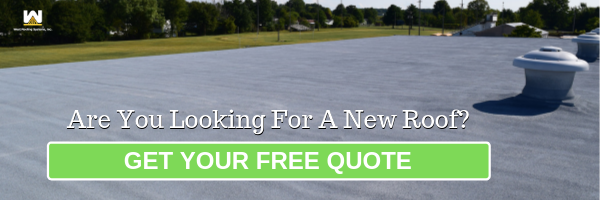Wednesday, April 17, 2019
Tuesday, April 9, 2019
5 Signs of a Reputable Roofing Contractor
You’ve probably heard all the horror stories: contractors that balloon quotes, projects slow to complete, down payment requirements or projects that disappear altogether.
At West Roofing Systems, we have been called out to fix the work of less-than-reputable contractors on numerous occasions for roofs that were improperly installed, shortcut, or even left unfinished.
It leaves property owners and facility managers frustrated, high and dry with a leaking roof. We hate to see that happen. That’s why we wrote this article: to share what you should look for when vetting potential commercial roofing contractors.
Open to Sharing Portfolio
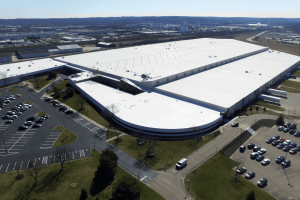 You should always ask your contractor to see their past work. This shouldn’t be a problem for someone who is proud of the work they have done. Whether they are in the form of portfolios, case studies or project write-ups; you want to make sure that not only have they completed jobs similar to your facility, but you want to see the type of work they do via photos and videos.
You should always ask your contractor to see their past work. This shouldn’t be a problem for someone who is proud of the work they have done. Whether they are in the form of portfolios, case studies or project write-ups; you want to make sure that not only have they completed jobs similar to your facility, but you want to see the type of work they do via photos and videos.
#theWRSway: You can see our case studies online here.
List of References Available
Any reputable contractor should have a list of happy clients that you can call and ask about their experience. If you do get a list, cross-check the information online to make sure it is valid, prepare a list of questions and make that short phone call. It may not be fun, but those few minutes could save you big dollars in the long run.
#theWRSway: West Roofing Systems has a long list of business partners that can speak to our reputation. Our technical reps also have extensive lists of customer references that represent a wide variety of products and services.
Properly Licensed and Insured
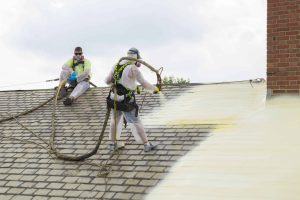
Any reputable, licensed contractor expects to be asked by customers to see their license or letter of Good Standing up front. If the contractor doesn’t provide a license in the first meeting, don’t hire until you see it.
Another essential aspect of hiring a contractor is to make sure they have the proper license to perform work on your building. Roofing can be dangerous work; you don’t want to be held liable if a contractor is injured on your property.
#theWRSway – West Roofing Systems is licensed to work in 15 states, and we have proof of insurance for any customer who requests to see it.
Custom Solutions
Your commercial facility is a big investment. If you are paying a contractor to do work on your building, make sure you pick a partner. Find a contractor that will listen to your problems and find the right solution for you.
Whether you have a small budget, or you need to replace your entire roof system. A good contractor will work with you to determine your options and pick the best option for your facility.
Reputable Billing Practices

The payment conversation should be made up front. Depending on the size of the project, there are a few ways a contractor may accept payment, but cash is usually not an option. And if cash is the only option, get away from that contractor right away.
You should be able to agree to payment terms up front; most have a set of terms that you should pay after the project is completed. Paying up front should be a red flag of a disreputable contractor.
Investing in a commercial roofing project can be a daunting task. But by being prepared and asking the right questions, you can find the right contractor to deliver high-quality work for a good price.
Although it would be just as easy for you to choose a different commercial roofing contractor in your area, choosing West Roofing Systems as a turnkey roofing company will provide you with highly trained teams and award-winning service. Our services are flexible and diverse; we can recoat, repair or replace your facility’s roof so that it lasts decades.
Original Post Here: 5 Signs of a Reputable Roofing Contractor
Tuesday, April 2, 2019
How Thermal Imaging is Used for Roof Inspections
How does your commercial roof look? On the surface, it may seem like your roof is in excellent condition, but many would be shocked to learn that their flat roof has minor leaks that could lead to mold, rot or even structural damage.
Roofing contractors and inspectors utilize the latest technology to get the most information about your roof system. The most common tool we use is thermal imaging or infrared imaging. Thermal imaging allows roofing contractors to see what is happening under the roof membrane.
The last thing you want to do is trap moisture into your roof system. By using thermal imaging on commercial roof surveys, a contractor can see if there is moisture present under the roof membrane and make the best decision on how to proceed with your roofing project.
Thermal Imaging for Roof Surveys
[caption id="attachment_26335" align="alignright" width="300"]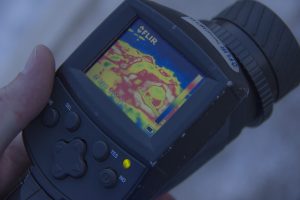 Infrared Survey[/caption]
Infrared Survey[/caption]
Infrared Moisture Surveys give contractors and inspectors the ability to see what is happening under your roof’s membrane without having to damage your roof system.
Thermal imaging has been used since the 1970s to help determine if your facility needs a total roof replacement or if your facility roof can be repaired in the damaged areas. They are an integral part of delivering the best quality roof at a fair price.
Our team at West Roofing Systems perform many, MANY thermal roof surveys for our customers. Our thermal survey team heads out in the evening on a clear night to get the best reading.
There need to be precise conditions for an infrared moisture survey to be successful:
- Flat or low-sloped roof
- The clean and dry roof surface
- Mostly sunny and warm during the day
- Little to no wind
- Clear night
What Does a Thermal Image Show?
You can see what is happening under the roof surface by the colors that appear on the imaging – whether it is a photo or video. Here are some photos of thermal imaging:
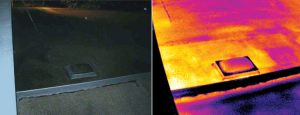
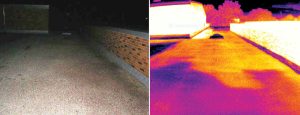
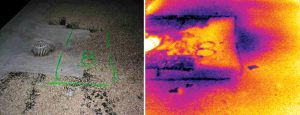
When looking at these images, you can see the color differences
- Cool Colors – Blues and Purples
- Warm Colors – Yellows, Reds, and Oranges
The areas in the photo that are shown in warm colors are areas of the roof that are holding in the heat from the sunlight during the day. The brighter, warm colors signify the more moisture that is underneath the membrane. As you can see in the photos above, these roofs need some work.
Why Roofers Use Thermal Imaging
[caption id="attachment_26334" align="alignright" width="300"]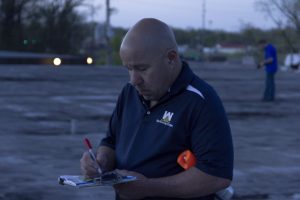 Greg Haas Performing a Commercial Infrared Survey[/caption]
Greg Haas Performing a Commercial Infrared Survey[/caption]
The benefits of utilizing thermal imaging, rather than another survey type, are numerous regarding cost, time and accuracy.
- Detects problems that cannot be visually identified
- Not invasive to your roof system
- Cost-Effective do to advanced technology and short survey time
- Plan a project accurately, saving time and money
- Eliminate unnecessary projects
West Roofing Systems provides free commercial roof surveys for all of our current and potential customers who are interested in having work done on their facility.
Our sales team and expert technicians perform a comprehensive roof analysis by inspecting conditions, establishing roof assembly through core samples to determine if the project will be on overlay or tear-off, and measuring roof area square footage.
Originally Published Here: How Thermal Imaging is Used for Roof Inspections
Wednesday, March 27, 2019
Cost of Single-Ply Membrane Commercial Roofing (2019)
Our sales team is asked every day, “How much does a single-ply membrane roof cost?” and it’s not easy to give just one answer. There are many factors that can affet rubber roofing prices; from the weather to the location to the material and installation.
In this article, we will review the average price of a single-ply membrane roof and break down factors that could change your price. Keep in mind that when you are looking to invest in a new roofing system, it’s a good idea to get multiple quotes from a couple contractors.
Single-Ply Membranes are sheets of rubber and other synthetics that can be chemically adhered or mechanically fastened to insulation or a cover board creating a layer of protection on your commercial facility.
Read More: Single-Ply Roofing Systems: Installation and Performance
For an average 20,000 sq. foot commercial roof, it will usually cost between $3.50 and $7.50 per square foot in materials and labor to install a typical single-ply membrane commercial roofing system.
To get the best rubber roofing prices, you will need to consider these key factors:
The Size of Your Roof
When a contractor is pricing a new roofing system, the economies of scale starts around 20,000 sq feet; which means after 20,000 sq. feet you can start saving money per square foot of roof.
[caption id="attachment_23998" align="alignright" width="300"] EPDM Roofing System[/caption]
Other size factors that can impact your cost also include:
- The logistics of moving equipment up to and across a large roof
- Debris removal costs
- Material transport costs – this cost can take up 2-3% of the total project costs
The Condition of Existing Roof
The condition of your existing roof will be a crucial factor in the cost of your new single-ply membrane roof. There are three options when dealing with the existing roof:
Clean and Prepare Existing Roof (no significant alterations) - $0.10 - $0.75 per sq. foot
When you have a solid roof that doesn’t require major modifications or corrections, the contractor will need to clean and prepare the roof, so the insulation adheres properly.
There are four ways a contractor can prepare a roof for single-ply membrane installation:
- Air Pressure Cleaning
- Powerwash
- Dry Vac/Ballast Removal
- Wet Vac for dirt, gravel and dust removal
Recovery Board Fastened on Top of the Existing Roof – $0.70 - $1.40 per sq. foot
Recovery boards are commonly used to cover and improve the application surface. This process could be used to cover joints and to provide a separation layer between the existing and new roofing systems.
Stripping and Removal of Roof - $1.00 - $2.00 per sq. foot
There are two main reasons a contractor would need to strip and remove your existing roof.
- A building can’t have more than two roofing systems. This means if you currently have two roofs, your contractor will need to remove them before installing your new roof.
- If your roof is damaged, saturated or unstable, your contractor will need to strip the existing roof to install a new working roof.
Access to Roof
[caption id="attachment_23977" align="alignright" width="300"] TPO Single-Ply Membrane Roofing[/caption]
Not all commercial roofs are flat; not all roofs can be walked on. Additional costs can occur when your contractor has limited access to the facility roof.
Height and distances of the roof can be multipliers for the cost of your single-ply membrane roof installation. Sloped roofs often require the contractors to use a man lift or repelling gear for single-ply membrane roof installation. Contractors may need to rent conveyance equipment such as a crane or passenger hoist to move the crew and equipment.
Insulation Choice
After the existing substrate is prepared, either by cleaning or removing the existing roof, the insulation is installed. In general, two layers of insulation are used.
There are a few types of insulation options the facility manager/owner can to choose from:
Polyisocyanurate (Polyiso)
Polyiso is the most commonly used insulation for roofing. It’s a rigid material that can be cut to size for installation. The R-Value for Polyiso lasts longer, and the aged R-Value is still higher than EPS and XPS.
Below are the costs for three different thicknesses:
- 1 in. - $1.40 - $1.75 per sq. foot in materials and labor
- 2 in. - $2.00 - $2.50 per sq. foot in materials and labor
- 3 in. - $2.80 - $3.15 per sq. foot in materials and labor
*Attached Polyiso cost associated with mechanical attachment would be based on industry average applications.
Expanded Polystyrene (EPS)
EPS can be used for roofing, walls or floor insulation, but more commonly used with concrete. You get more R-Value per dollar with EPS being the lowest cost insulation choice.
Extruded Polystyrene (XPS)
XPS insulation can be found in blue, pink or green and is most commonly used for wall insulation. This is probably what you think when you hear insulation because it is the middle of the road in terms of cost and R-Value.
Read More: Choosing Rigid Foam by Green Building Advisor
Membrane Choice
[caption id="attachment_23972" align="alignright" width="300"] EPDM Single-Ply Roofing System[/caption]
When you are considering single-ply membrane roofing, there are two types of membrane to choose from: TPO and EPDM.
TPO
Thermoplastic Polyolefin is a single-ply roofing membrane that is one of the fastest growing commercial roofing systems on the market. TPO roofing systems are made up of a single layer of synthetics and reinforcing scrim that can be used to cover flat roofs.
For an average 20,000 sq. foot commercial roof, it will usually cost between $1.90 and $3.50 per square foot in materials and labor to for a TPO membrane.
EPDM
Ethylene Propylene Diene Monomer is a single-ply membrane that consists of a synthetic rubber compound that allows it to be flexible. EPDM has been used on commercial roofing facilities since the 1960s and is considered a time-tested option.
For an average 20,000 sq. foot commercial roof, it will usually cost between $1.80 and $3.50 per square foot in materials and labor to for an EPDM membrane.
Infographic: TPO vs. EPDM Systems
Installation Choice
[caption id="attachment_23999" align="alignright" width="300"] TPO Installation[/caption]
When it comes to installing the membrane of your choice to your roof (whether it’s to the insulation or to a cover board), there are three ways to choose from: Ballasted, Fastened or Adhered. They each have their own advantages and disadvantages when it comes to price, longevity, and ease of installation.
Download: Roofing Contractor Quote Checklist
Ballasted
A Ballasted attachment is a low-cost option. It consists of laying down the membrane (TPO or EPDM) and covering it with gravel, pavers, river rock, and other similar materials. While this option can save you money (and look pretty cool), it adds up to 10 pounds per square foot onto your building structure. And as the rocks degrade over time, they can easily damage the membrane underneath. Maintaining this type system is very difficult since the ballast would need to be moved to see any deficiencies in the membrane.
Fastened
Fastened attachment is when the membrane (TPO or EPDM) is mechanically attached to the cover board with metals screws and plates. These are inserted along the seams of the membrane sheet.
Adhered
A chemically adhered membrane is rolled out onto the cover board after a bonding adhesive is applied. This method does not penetrate the membrane which alleviates the chance of leaks even more.
Cost Table
Depending on the type of membrane thickness of membrane and type of attachment, your cost could vary.
Below is a table of cost estimates based on an average size roof:
| 045 mils Thickness | 065 mils Thickness | |
| TPO | ||
| Ballasted | $1.90 - $2.35 per sq. foot | $2.00 - $2.50 per sq. foot |
| Fastened | $2.50 - $3.00 per sq. foot | $2.65 - $3.15 per sq. foot |
| Adhered | $2.75 - $3.25 per sq. foot | $2.85 - $3.50 per sq. foot |
| EPDM | ||
| Ballasted | $1.80 - $2.25 per sq. foot | $2.00 - $2.35 per sq. foot |
| Fastened | $2.00 - $2.25 per sq. foot | $2.20 - $2.70 per sq. foot |
| Adhered | $2.80 - $3.20 per sq. foot | $3.00 - $3.50 per sq. foot |
Roof Penetrations
[caption id="attachment_23979" align="alignright" width="300"] TPO Single-Ply Membrane around Roof Penetration[/caption]
Most commercial roofing systems have accessories attached such as A/C units, skylights, air vents, plumbing vents and more. These penetrations on the roof can be in the way of rolling out a straight section of membrane.
When the contractor approaches these penetrations with single-ply membrane roofing, they need to cut smaller membrane pieces to size and essentially building up the roof around the vents/units which takes up more time and can cost more money to work around.
Type of Warranty
When you install a new single-ply membrane roofing system, you will have a few warranty options. The three most common types of warranties include:
- Contractor’s Warranty - No expense or less than $1,000
- Manufacturer’s Product Warranty - Low cost and low coverage
- Manufacturer’s Full System Warranty - $0.08 - $0.15 per sq. foot
Single-Ply Membrane Roofing Systems have been the go-to roofing for commercial, industrial, and manufacturing facilities for decades. Contact West Roofing Systems today to talk to our expert staff about rubber roofing prices and your future Single-Ply Membrane Roofing System.
Original Post Here: Cost of Single-Ply Membrane Commercial Roofing (2019)
Thursday, March 21, 2019
Roofing in Alabama: How to Protect Your Building
Is your roof holding up to your local climate and weather?
The are several types of climate areas across the US, and each has their obstacles that building owners have to face to protect their building. In Alabama, we experience harsh weather from sun and heat to severe rain and wind.
Roof systems in Alabama have to stand up to a lot of wear and tear. In this article, we cover the top roofing problems we see in Alabama along with the top types of roofing systems Alabamians rely on to protect their buildings.
Weather in Alabama
 Heat
Heat
We have an office and facility in Huntsville, so we understand the needs of our fellow building owners and managers to save on energy costs. The temperature of an Alabama summer can put a drain on not only your employees and tenants, but you don’t want to strain your HVAC system. Emphasizing an insulated roof system is the only way to go, to protect your building from extreme heat and overworked HVAC units.
Sun
Boy, do we have some sun here in Alabama! Prolonged exposure to the harsh sun during the summer months can age your membrane roof. The UV damage can break down a membrane faster than a roof system that is shaded.
Wind and Storms
Watch out for that storm! Your facility needs to be durable and can withstand hurricane-force winds and torrential rains. Building owners have to take into account uplift resistance and building protection from severe storms and tornadoes.
Popular Roof Types for Alabama

Spray Foam
Spray Polyurethane Foam (SPF) is an eco-friendly roofing option for commercial, industrial and manufacturing facilities. Spray Polyurethane Foam, more commonly referred to as SPF, is a material that is sprayed as a liquid so it can expand into a foam, creating a solid layer across an existing roof.
Read More: Spray Polyurethane Foam (SPF) Roofing: Installation & Performance
Single-Ply
Single-Ply Membrane is a time-tested roofing option for commercial, industrial and manufacturing facilities. Single-Ply Membranes are sheets of rubber and other synthetics that can be ballasted, mechanically fastened or chemically adhered to insulation creating a layer of protection on your commercial facility.
Metal
Metal Roofing is one of the oldest commercial roofing systems on the market. Most metal roofing systems use corrugated galvanized steel, although other materials such as aluminum or tin can also be used.
Since metal roofing material is rather light in weight, it can be installed right on top of the existing roof. After a metal roofing system is installed, a coating can be added for waterproofing, rust protection, and UV protection.
Alabama has some pretty crazy weather, but we can help you be prepared! If you have any further questions about your commercial roofing system, email us anytime at info@westroofingsystems.com or by filling out our form online to find out more.
Originally Published Here: Roofing in Alabama: How to Protect Your Building
Tuesday, March 19, 2019
5 Tips to Prepare Your Roof for Hurricane Season
A hurricane can be a scary time. But if you live in a hurricane-prone area, you are probably a pro! Whether you are a business owner or building owner, you want to protect your property during hurricane season.
In this article, we cover when hurricane season is, what kind of damage hurricanes cause and 5 tips for preparing your roof for hurricane season.
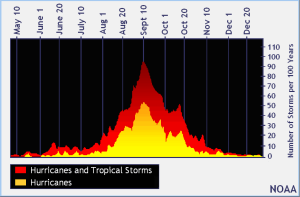 When is Hurricane Season?
When is Hurricane Season?
“The official hurricane season for the Atlantic Basin (the Atlantic Ocean, the Caribbean Sea, and the Gulf of Mexico) is from 1 June to 30 November” according to the National Hurricane Center. “The peak of the season is from mid-August to late October.”
What Kind of Damage Can Hurricanes Cause?
 Wind Damage
Wind Damage
It’s crazy how something you can’t even see can cause so much damage. Wind can cause a ton of havoc to your roof. Wind can cause damage in a number of ways:
- Blow off roof or roof accessories
- Throwing items onto your roof
- Ripping mounted hardware out of your roof
Water Damage
Where there are strong winds, water and hail are likely to be close behind. Where the wind can cause damage to your roof system, there are vulnerable areas for water to enter your building. This water can cause issues with your building insulation, structure, and your property inside.
Read More: 5 Common Causes of Commercial Roof Leaks
How to Prepare Your Roof for Hurricane Season
 1. Schedule an Evaluation
1. Schedule an Evaluation
If you are in a hurricane-prone area, yearly roof evaluations are a must. Having a knowledgeable contractor on your roof before hurricane season will ensure that there are no issues on your roof that a hurricane can make worse. Before hurricane season is the best time to have a contractor perform repairs and double check the integrity of your roof.
Your roofing contractor will look at the following areas of your roof:
- Membrane – make sure there are no rips, punctures, holes or effects of aging.
- Flashings – make sure all flashings are correctly attached and sealed.
- Mounted Equipment – make sure the penetrations are properly sealed and that the equipment is securely attached.
- Gutters/Downspouts – make sure all gutters, drains, and downspouts properly attached and flowing to the proper location.
You can even do one better with two yearly inspections: one before and one after hurricane season.
2. Trim Nearby Trees
Strong winds of a hurricane can destroy buildings and throw cars across town, do you trust those tree branches that hang over your building?
When you reach May or June, right before hurricane season, take a walk around your building and identify dead, broken or oversized trees and tree branches. These can easily be blown off during a storm and land on your building.
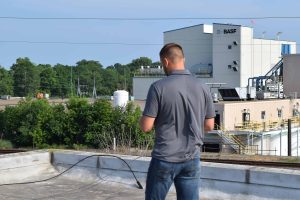 3. Continue with Regular Maintenance
3. Continue with Regular Maintenance
A maintenance program is a great way to be proactive with your roof system. Having a roofing contractor keep up the maintenance of your roof is one of the best ways to ensure that your roof is ready to stand up to incoming hurricanes.
Regular maintenance can catch preliminary roof issues before they get worse, saving you money.
Read More: Creating A Flat Roof Maintenance Plan to Last All Year
4. Clear Gutters and Drains
We discussed above the damage that can come from water during and after a hurricane. Cleaning and making sure your gutters are clear is essential because your gutter system takes water from your roof system down to the ground.
If your gutters are clogged, the backed-up water will sit on your roof, and the probability of water entering your building will increase.
Read More: Commercial Gutters: Why Are They Important and How to Maintain Them
5. Keep Up to Date with Insurance and Warranties
When a hurricane passes through your area, it can be chaotic in the aftermath. You can be a step ahead of your competitors and neighbors by having all of your documentation prepared and in a safe and easily accessible place.
Ideas of documents to keep:
- Any applicable warranties
- Insurance documentation
- Any before photos
- Contact information for contractors, insurance agents and other key contacts
When hurricane season comes, protecting people is the most important. With a thought-out and well-implemented preparation plan, you don’t have to think twice about your roof during a hurricane.
Contact our team today to evaluate and help prepare your roof for the upcoming hurricane season.
Source Here: 5 Tips to Prepare Your Roof for Hurricane Season
Thursday, March 14, 2019
Cost of Silicone Restoration Membrane for a Commercial Roof (2019)
One of the most important questions we get when looking at roofing projects is, “What will this cost me?” Our sales team works with property owners and facility managers to keep their buildings dry and safe…within their budget.
We are happy to save owners and managers money by restoring their commercial roof system with a silicone restoration membrane (SRM or Silicone Roof Coating) and bypassing the need to replace the entire system.
A Silicone Roof Coating can save you thousands of dollars in materials, labor and time.
In this article, we break down the costs of a Silicone Roof Coating and what you should consider when looking to install a silicone roof coating on your commercial roof.
What is a Silicone Restoration Membrane?
A Silicone Restoration Membrane is a fluid applied silicone coating sprayed directly onto an existing roof system. Facility owners and managers tend to opt for a roof coating, usually, silicone when their roofing systems are in good shape but just need a renewal from age and normal wear and tear.
Read More: Silicone Restoration Membrane: Installation and Performance
The process of installing a silicone restoration membrane is relatively straightforward:
- Inspection and Repairs
- Seam Reinforcement
- Silicone Application
- Warranty
If your commercial flat roof is in good working condition, you can install a silicone restoration membrane to extend the life of your roof and renew your warranty. But how much does it cost?
For an average 20,000 sq. foot commercial roof, it will usually cost between $2.00 and $3.50 per square foot in materials and labor to install a typical Silicone Restoration Membrane System.
To get the best roofing system for the right price, you will need to consider these key factors:
Infrared Survey
Before a silicone roof coating is applied, the contractor will perform an infrared survey to examine the condition of the insulation under the roof. An Infrared Moisture Survey is a terrific way to visually see the quality of the insulation across a wide area.
When the temperature drops in the evening, your contractor will take photos of your roof with an infrared camera. These photos will tell visually where the insulation is wet under the membrane. By using these photos, your contractor knows where they need to replace the underlying insulation.
Read More: Do I Need a Commercial Roof Inspection or Survey?
Roof Repairs
[caption id="attachment_24652" align="alignright" width="225"] SRM Roof Repairs[/caption]
If your commercial roof needs minor repairs, those can factor into the cost of your Silicone Restoration Membrane.
Since your roof is being restored with a silicone coating, most of the roof surface is in good condition. The repairs are usually less than 25% of the roof, keeping the rest of the serviceable roof service. Repairs before a silicone restoration coating costs between $0.70 – $1.40 per sq. foot in materials and labor.
The contractors will remove any saturated insulation, replace the area with new, like insulation (polyiso is repaired with polyiso and so on). The areas being repaired are patched up and ready for the entire roof to be cleaned.
Read More: Commercial Roof Preventative Maintenance and Repair
Power Washing
After the inspection and contract are both completed, your contractor will start the silicone roof coating application by power washing the surface of the roof. It’s important to thoroughly clean the roof surface from debris and dirt so that the silicone will adhere properly.
There are two ways a contractor can power wash a commercial roof:
Traditional Spinning Head/ Power Washer Wand - $0.20 - $0.35 per sq. foot
This is the most popular way to power wash a commercial roof and usually the process a contractor will take. The contractor will use a power wash wand or a machine with a spinning brush to clean the surface of the roof.
Then the contractor will need to dry to the surface of the roof with a powerful air dryer, or they will have to let the roof dry naturally overnight or over the course of a few days. This process can lengthen the duration of the project.
Reclamation Washing - $0.30 - $0.50 per sq. foot
The less popular, but eco-friendlier power washing option is a reclamation washing process. This process uses a heated high-pressure water with a spinning brush to clean the roof surface. As the water is cleaning the roof surface, the attached vacuum sucks up the water, processes it through a filtration system and then disposes of it properly in the facility’s sewer system. This process uses less water, collects used water and takes a shorter amount of time for the roof surface to dry.
Membrane Seam Repair
[caption id="attachment_24653" align="alignright" width="225"] SRM Seam Repair[/caption]
After any repairs are made to your roofing system, the contractor will reinforce all of the existing seams across your roof. This seam reinforcement simply adds a layer of mesh and coating or self-adhesive tape to further prevent leaks with the more vulnerable areas of the roof.
There are two common types of seam reinforcement.
Polyester Mesh with Coating - $2.20 - $2.50 per sq. foot
Installing a polyester reinforced mesh into a liquid top coating and then an additional silicone coating after the topcoat has cured.
Self-Adhesive Tape - $4.00 - $4.50 per sq. foot
To reinforce the seams, flashings, and penetrations with a self-adhering, reinforcing tape that would then receive a liquid topcoat. This process costs more, but it can save money on time a labor because it is a quicker process for the contractor.
Silicone Coating
The final application is the actual silicone coating. The Silicone Roof Coating is sprayed on or roller applied over the entire surface of the roof adding a seamless, waterproof layer to your commercial flat roof to protect the existing roof, repairs, and seams from water.
The number of layers and thickness of layers depends on the brand of material/manufacturer your contractor is using. Some manufacturers allow one coat of silicone, while others require two. Different manufacturers will offer contractor certifications, so ask your contractor what brands they use and if they are certified/licensed by their preferred manufacturers.
Cost Table:
| Industry Average 10 Year Warranty Application | |
| 1 Coat | $1.40 - $1.87 per sq. foot |
| 2 Coats | $1.78 - $2.10 per sq. foot |
| Industry Average 15 Year Warranty Application | |
| 1 Coat | $2.10 - $2.45 per sq. foot |
| 2 Coats | $2.45 - $2.50 per sq. foot |
Read More: Silicone Restoration Membrane for Commercial Facilities
Warranty Fees
After the Silicone Roof Coating is applied and completed, it will be inspected by a 3rd party to ensure that the silicone was properly applied to the manufacturer’s specifications. When the roof coating passes the inspection, the warranty will be issued to the facility owner/manager.
The cost of the warranty is determined by the length of the warranty and the manufacturer.
- 10 Year Manufacturer’s Warranty - $0.07 - $0.10 per sq. foot
- 15 Year Manufacturer’s Warranty - $0.11 - $0.15 per sq. foot
So, there you have it. For an average 20,000 sq. foot commercial roof, it will usually cost between $2.00 and $3.50 per square foot in materials and labor to install a typical Silicone Restoration Membrane System.
If you have any further questions about what your Silicone Restoration Membrane System will cost, email us anytime at info@westroofingsystems.com or by filling out our contact form online to find out more.
*Cost ranges are general estimates; each roofing system is unique, and costs can vary. Please seek a professional quote for more specific and reliable costs.
Article Here: Cost of Silicone Restoration Membrane for a Commercial Roof (2019)
Roofing in Georgia: How to Protect Your Building
Is your roof holding up to your local climate and weather?
The are several types of climate areas across the US, and each has their obstacles that building owners have to face to protect their building. In Georgia, we experience harsh weather from severe rain and wind to harsh heat.
Roof systems in Georgia have to stand up to a lot of wear and tear. In this article, we cover the top roofing problems we see in Alabama along with the top types of roofing systems Georgians rely on to protect their buildings.
Weather in Georgia
Heat
We have an office and facility in Tunnel Hill, GA, so we understand the needs of our fellow building owners and managers to save on energy costs. The temperature of a Georgia summer can put a drain on not only your employees and tenants, but you don’t want to strain your HVAC system. Emphasizing an insulated roof system is the only way to go, to protect your building from extreme heat and overworked HVAC units.
Sun
Where there is heat, there is the sun. Roofs that have extended exposure to sun tend to degrade faster. A solid maintenance plan and the proper roof to deflect sunlight and UV rays can help extend the life of your roof.
 Wind and Severe Storms
Wind and Severe Storms
Your facility needs to be durable and can withstand tornado-force winds. Building owners have to take into account uplift resistance and building protection from severe storms and tornadoes. From winter winds to springtime tornado season, the wind is one of the top causes of damage to buildings and homes.
Gutter Damage and Maintenance
Severe storms can affect more than just the roof. Gutters are a huge component to your roof system that is often overlooked. Damaged or improperly working gutters leave water sitting on your roof and can cause leaks in your building.
Read More: Commercial Gutters: Why Are They Important and How to Maintain Them
Popular Roof Types for Georgia
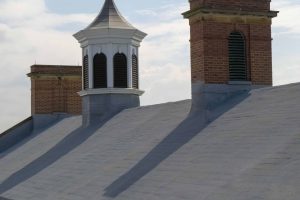 Spray Foam
Spray Foam
Spray Polyurethane Foam (SPF) is an eco-friendly roofing option for commercial, industrial and manufacturing facilities. Spray Polyurethane Foam, more commonly referred to as SPF, is a material that is sprayed as a liquid so it can expand into a foam, creating a solid layer across an existing roof.
Read More: Spray Polyurethane Foam (SPF) Roofing: Installation & Performance
Single-Ply
Single-Ply Membrane is a time-tested roofing option for commercial, industrial and manufacturing facilities. Single-Ply Membranes are sheets of rubber and other synthetics that can be ballasted, mechanically fastened or chemically adhered to insulation creating a layer of protection on your commercial facility.
Metal
Metal Roofing is one of the oldest commercial roofing systems on the market. Most metal roofing systems use corrugated galvanized steel, although other materials such as aluminum or tin can also be used.
Since metal roofing material is rather light in weight, it can be installed right on top of the existing roof. After a metal roofing system is installed, a coating can be added for waterproofing, rust protection, and UV protection.
Georgia has some pretty crazy weather, but we can help you be prepared! If you have any further questions about your commercial roofing system, email us anytime at info@westroofingsystems.com or by filling out our form online to find out more.
Article Here: Roofing in Georgia: How to Protect Your Building
Tuesday, March 12, 2019
Cost of a Spray Polyurethane Foam Roofing System (2019)
Our sales team is asked every day, “How much does a Spray Polyurethane Foam (SPF) roof cost?” and it’s not easy to give just one answer.
There are many factors that can affect the price of a commercial roof; from the weather to the location to the material choices.
[caption id="attachment_22199" align="alignright" width="274"] Prairie State College after West Roofing Systems installs new SPF roof[/caption]
Here at West Roofing Systems, we’ve installed over a 59,000,000 sq. feet of roofing domestically and internationally and during that time we have noticed that it can be tough to answer, “How much does a Spray Polyurethane Foam (SPF) roof cost.”
So, in this article, will review the average price of an SPF roof and break down factors that could change your price. Keep in mind that when you are looking to invest in a new roofing system, it’s a good idea to get a couple of quotes from different contractors.
For an average 20,000 sq. foot commercial roof, it will usually cost between $4.00 and $7.00 per square foot in materials and labor to install a typical SPF roofing system. This price range is for an SPF roof of average thickness and building structure.
To get the best roofing system for the right price, you will need to consider these key factors:
The Size of Your Roof
When a contractor is pricing a new roofing system, the economies of scale start around 20,000 sq feet; which means after 20,000 sq. feet you can start saving money per square foot of roof.
Other size factors that can impact your cost also include:
- The logistics of moving equipment up to and across a large roof
- Debris removal costs
- Material transport costs – this cost can take up 2-3% of the total project costs
Thickness of the SPF
[caption id="attachment_23024" align="alignright" width="300"] Recommended insulation levels across the US[/caption]
On average, it costs $1.65 - $2.25 per square foot for materials and labor on a typical SPF roofing system, which is a 1.5in layer of foam. Although there are reasons that a building will need a thicker layer, the most common reason is for energy efficiencies.
The thicker you make the foam layer, the high R-Value your roof will have. An R-value is the measure of insulation (resistance to heat flow) for material. All states or regions have that require that a roof system has a minimum amount of thermal resistance on commercial, industrial, and institutional buildings.
Basically: the higher the R-value, the more the material insulates.
You can work with your architect or contractor to compare the energy cost savings to the additional SPF costs to find where you can save money. Studies show that SPF Roofing has the most rapid return on investment from energy savings.
Condition of Existing Roof
The condition of your existing roof will be a crucial factor in the cost of your new SPF roof. There are three options when dealing with the existing roof:
[caption id="attachment_22117" align="alignright" width="300"] Before SPF Roofing Installation[/caption]
Clean and Prepare Existing Roof (no significant alterations) - $0.10 - $0.75 per sq. foot
When you have a solid roof that doesn’t require major modifications or corrections, the contractor will need to clean and prepare the roof, so the foam adheres properly.
There are four ways a contractor can prepare a roof for SPF installation:
- Air Pressure Cleaning
- Powerwash
- Dry Vac/Ballast Removal
- Wet Vac for dirt, gravel and dust removal
Recovery Board Fastened on Top of the Existing Roof – $0.60 - $0.80 per sq. foot
Recovery boards are commonly used to recover and improve the application surface. This process could be used to cover joints and to provide a separation layer between the existing and new roofing systems.
Stripping and Removal of Roof - $1.00 - $2.00 per sq. foot
There are two main reasons a contractor would need to strip and remove your existing roof.
- A building can’t have more than two roofing systems. This means if you currently have two roofs, your contractor will need to remove them before installing your new roof.
- If your roof is damaged, saturated or unstable, your contractor will need to strip the existing roof to install a new working roof.
Silicone Coating
When the SPF layer has been completed, it is then sealed with a layer of silicone and embedded granules. These layers protect the roof and foam from UV light, weather, and impact. The cost is between $1.75 and $2.30 per sq. foot in labor and materials to install.
There is a two-coat minimum of the silicone coating. You can increase the thickness of the silicone layer depending on the warranty you choose. For example, a 20-year warranty will need a thicker layer of silicone than a 10-year warranty.
Access to Roof
[caption id="attachment_23026" align="alignright" width="300"] WRS Employee Rappeling for Sloped Roof Installation[/caption]
Not all commercial roofs are flat; not all roofs can be walked on. Additional costs can occur when your contractor has limited access to the facility roof.
Height and distances of the roof can be multipliers for the cost of your SPF roof installation. Sloped roofs often require the contractors to use a man lift or rappelling gear for SPF installation. Contractors may need to rent conveyance equipment such as a crane or passenger hoist to move the crew and equipment.
When teams are working on secure locations, such as an airport, they often need to keep up their Secure Identification Display Area (SIDA) authorization. This includes background checks and fingerprinting, which is an added cost for the contractors.
Read More: SPF Roofer Qualifications
Type of Warranty
When you install a new SPF roofing system, you will have a few warranty options. The three most common types of warranties include:
- Contractor’s Warranty - No expense or less than $1,000
- Manufacturer’s Product Warranty - Low cost and low coverage
- Manufacturer’s Full System Warranty - $0.08 - $0.15 per sq. foot
Maintenance
You can save a lot of money by simply keeping up with the maintenance of your SPF roofing system. There are two types of maintenance: preventative maintenance and a restoration coating.
Preventative Maintenance
It is recommended that your SPF roof is inspected twice a year:
- Fall Inspection – Clear leaves from drains, prepare for winter
- Spring Inspection – Look for damage from the winter weather
A visual inspection including general maintenance is a rather inexpensive way to maintain the integrity of your SPF roof at $0.2 - $0.5 per sq. foot. Any roofing contractor can perform inspections on your SPF roof, but you should hire a certified SPF roofing contractor to perform repairs.
Silicone Restoration Coating
[caption id="attachment_22182" align="alignright" width="256"] Before and after silicone restoration coating[/caption]
Silicone Restoration Coating is an economical and environmentally friendly alternative to re-roofing. The average cost range for a silicone restoration coating is $2.00 - $5.00 per sq. foot.
Your contractor will make sure that the existing surface is clean and dry, and apply a new layer of silicone coating to the roof. This will restore the top layer of your roof and repair any punctures or other issues your roof is experiencing.
Read More: Silicone Restoration Membrane: Installation and Performance
So, there you have it – our costs for spray polyurethane foam roofing systems. When you include the SPF, silicone coating, size, and access to the facility, warranty, and maintenance, the average cost of an SPF roofing system is between $4.00 and $7.00 per square foot. It’s important to remember that based on your roofing contractor, location, and building, these prices will vary.
If you have any further questions about what your spray polyurethane foam roofing system will cost, email us anytime at info@westroofingsystems.com or by filling out our contact form online to find out more.
*Cost ranges are general estimates, each roofing system is unique and costs can vary. Please seek a professional quote for more specific and reliable costs.
Post Source Here: Cost of a Spray Polyurethane Foam Roofing System (2019)
Thursday, March 7, 2019
Roofing in Ohio: How to Protect Your Building
Is your roof holding up to your local climate and weather?
The are several types of climate areas across the US, and each has their obstacles that building owners have to face to protect their building. In Ohio, we experience harsh weather twice a year. From snow, ice and freezing temperatures in the Winter, to hot, humid and sunny weather in the summer.
Roof systems in Ohio have to stand up to a lot of wear and tear. In this article, we cover the top roofing problems we see in Ohio along with the top types of roofing systems Ohioans rely on to protect their buildings.
Roof Problems in Ohio

Heavy Snow
If you have a building in Ohio, you know that when it snows, it snows hard. Seasonal snow can test your roof in a couple of ways:
- Weight – Snow adds a lot of pressure onto your building’s structure.
- Melting Snow – Melting snow can overwhelm your gutter system if they are not properly maintained, causing water to back up onto your roof.
Ice
The biggest problem our service team sees in the winter is when water enters a small hole or puncture in a roof, that water turns to ice which expands, then melts…leaving a bigger problem with your roof.
Nearby Trees
Ohio has some beautiful trees; we are lucky to have trees everywhere! Unfortunately, these trees can bring some problems with your roof system.
- Winter – Snow, and ice can fall from nearby trees onto your roof. If it snows enough in a short amount of time, branches can break and cause significant damage to your building.
- Summer – Summer and Spring bring vegetation and animals to the area. Falling leaves, branches and flowers can clog your drain system and create damage to your roof.
Sun
Ohioans are always relieved when the summer sun comes out! But that harsh sun during the summer months can age your membrane roof. The UV damage can break down a membrane faster than a roof system that is shaded.
Popular Roof Types for Ohio
Spray Foam
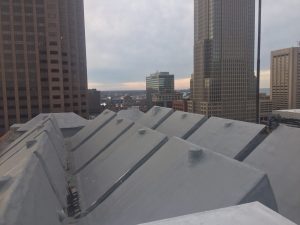 Spray Polyurethane Foam (SPF) is an eco-friendly roofing option for commercial, industrial and manufacturing facilities. Spray Polyurethane Foam, more commonly referred to as SPF, is a material that is sprayed as a liquid so it can expand into a foam, creating a solid layer across an existing roof.
Spray Polyurethane Foam (SPF) is an eco-friendly roofing option for commercial, industrial and manufacturing facilities. Spray Polyurethane Foam, more commonly referred to as SPF, is a material that is sprayed as a liquid so it can expand into a foam, creating a solid layer across an existing roof.
Read More: Spray Polyurethane Foam (SPF) Roofing: Installation & Performance
Single-Ply
Single-Ply Membrane is a time-tested roofing option for commercial, industrial and manufacturing facilities. Single-Ply Membranes are sheets of rubber and other synthetics that can be ballasted, mechanically fastened or chemically adhered to insulation creating a layer of protection on your commercial facility.
Metal
Metal Roofing is one of the oldest commercial roofing systems on the market. Most metal roofing systems use corrugated galvanized steel, although other materials such as aluminum or tin can also be used.
Since metal roofing material is rather light in weight, it can be installed right on top of the existing roof. After a metal roofing system is installed, a coating can be added for waterproofing, rust protection, and UV protection.
Ohio has some pretty crazy weather, but we can help you be prepared! If you have any further questions about your commercial roofing system, email us anytime at info@westroofingsystems.com or by filling out our form online to find out more.
Originally Published Here: Roofing in Ohio: How to Protect Your Building
Thursday, February 28, 2019
Flat Roof Coating: How You Can Save Money
At West Roofing Systems, we’ve been restoring commercial roof systems to working order while saving facility owners and managers thousands of dollars in repairs and roof replacements.
If your commercial flat roof is in fair working condition, you can install a silicone restoration membrane to extend the life of your roof and renew your warranty.
What Are Roof Coatings?
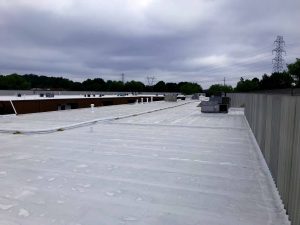 A Silicone Restoration Membrane is a versatile and self-flashing silicone membrane material perfect for economic roof renewal. After the existing roof is clean and repaired, the silicone coating is sprayed on, sealing any imperfections and adding a waterproof layer on your commercial roof.
A Silicone Restoration Membrane is a versatile and self-flashing silicone membrane material perfect for economic roof renewal. After the existing roof is clean and repaired, the silicone coating is sprayed on, sealing any imperfections and adding a waterproof layer on your commercial roof.
The process of installing a silicone restoration membrane is relatively straightforward:
- An infrared inspection is performed to see if there are any wet areas of insulation under the membrane.
- After any saturated areas have been removed and replaced, the entire roof surface is power washed clean to remove any contaminants.
- The seams of the membrane are then reinforced with a self-adhesive tape or mesh and coating.
- The silicone coating membrane is sprayed on or roller applied over the entire surface of the roof creating a seamless membrane.
- After the silicone coating membrane has been completed, a final inspection will be performed by a third-party or the manufacturer’s representative to verify that all the necessary repairs were performed correctly and that the silicone is applied accurately. When the repairs and silicone membrane coating are approved, the warranty is issued.
Read More: Cost of Silicone Restoration Membrane for a Commercial Roof
Types of Roof Coatings
Silicone
[caption id="attachment_26914" align="alignright" width="300"]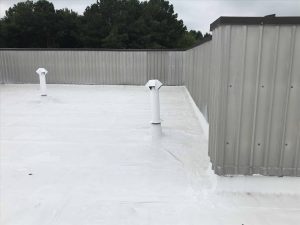 A silicone restoration membrane in Peachtree Corners, Georgia.[/caption]
A silicone restoration membrane in Peachtree Corners, Georgia.[/caption]
Silicone roof coating is elastomeric and made of silicone polymers. It’s known for the great weatherability and UV resistance to protect the roof system underneath. The reflective properties of the bright white silicone contribute to the ‘Cool Roof’ name and provide energy savings for the facility.
The silicone material is preferred for areas with drastic seasonal changes because the elasticity allows normal expansion and contraction with the building structure.
Read More: Silicone Restoration Membrane: Installation and Performance
Acrylic
Acrylic roof coating is a water-based coating made with acrylic resin. If you are looking for a custom color roof coating, acrylic gives you that ability. The elastomeric qualities expand and contract with the roof while forming a seamless seal.
Since the coating is water-based, it has a narrow temperature window for the application (50º F or higher) and slow cure time (7 days) can make it difficult to schedule your project.
See More: Silicone Vs. Acrylic Commercial Roof Coatings [Infographic]
Urethane
Urethane roof coating is a solvent-based coating that is becoming more popular on the roofing market. There are two types of urethane roof coatings: aromatic and aliphatic. These coatings have an excellent tensile strength to protect high-stress areas (walkways, penetrations, flashings, etc.)
Butyl
Butyl roof coating is solvent-based and serves as an excellent vapor barrier. The superior elongation and high tensile strength make it very durable without cracking. The high volatile organic content is not environmentally friendly and means that it can’t be used in low VOC states.
How Roof Coatings Save You Money
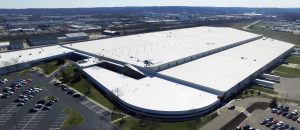 Many facility owners choose to restore their commercial roofs rather than replace them when the warranty comes to expire. This is a smart choice that can save them money, create energy savings and renew their warranty coverage.
Many facility owners choose to restore their commercial roofs rather than replace them when the warranty comes to expire. This is a smart choice that can save them money, create energy savings and renew their warranty coverage.
One of the top benefits of a Silicone Restoration Membrane is the cost savings. As long as the existing roof substrate is dry and stable, no roof removal is required. In this case, we make preventative repairs to the existing system and install a brand-new silicone coating that acts as a waterproof roof system over the current substrate.
Whether your roof is flat or pitched, an SRM can handle any type of roof, including those with skylights, vents, HVAC units, and drainage systems. Our experienced project managers and applicators bring decades of roofing experience to each job. West Roofing Systems knows when to repair or replace a roof, giving you options that ensure the best solution at the best price.
The best way to find out if your facility is eligible for a roof coating is to schedule for a contractor to evaluate your existing roof system. They will be able to recommend the best solution for your facility needs.
Silicone Restoration Membranes are an eco-friendly, cost-effective, alternative to replace your commercial roofing facility. Contact West Roofing Systems today to talk to our expert staff about your future SRM system.
Original Post Here: Flat Roof Coating: How You Can Save Money
Monday, February 18, 2019
Spray Foam Roofing and Solar Panels: The Ultimate Match
Solar roofing is a trend that is growing from Fortune 500 companies to SMBs all over the US. With the cost-savings, inflation protection and contributions to saving the environment, it may be one of the best facility decisions you make.
But if you install those solar panels on a roof system that is not equipped to handle them, you can be causing more trouble than you are saving. In this article, we will cover solar panels, spray foam roofing and how they are a match made for your facility.
What is Spray Foam Roofing?
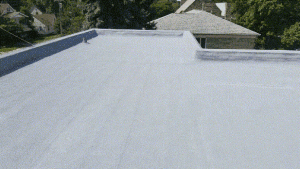 Spray Polyurethane Foam, more commonly referred to as SPF, is a liquid that is sprayed and expands into a foam, creating a solid layer across an existing roof. While SPF roofing is not the most known type of roofing material, the technology has been around since the early 1960s for industrial, commercial, and residential facilities.
Spray Polyurethane Foam, more commonly referred to as SPF, is a liquid that is sprayed and expands into a foam, creating a solid layer across an existing roof. While SPF roofing is not the most known type of roofing material, the technology has been around since the early 1960s for industrial, commercial, and residential facilities.
Read More: Spray Polyurethane Foam (SPF) Roofing: Installation & Performance
For an average 20,000 sq. foot commercial roof, it will usually cost between $4.00 and $7.00 per square foot in materials and labor to install a typical SPF roofing system. This price range is for an SPF roof of average thickness and building structure. *
What are Solar Panels?
Solar panel roof systems, aka photovoltaic systems, are growing popularity for residential and commercial buildings. With a push for more sustainable power along with the affordability of solar panels, it is a no-brainer for some building owners who have roof space to spare.
See More: Solar Benefits for Business
In case you don’t know, solar panels are installed on the outside of your building and convert light from the sun into energy for your building to run on. The solar roof system on a roof is made up of solar cells bundled together to make a panel, that panel is then combined with other panels to make a grid.
Rooftop solar systems can vary significantly in size. Large-footprint buildings can employ solar systems rated from 50 kilowatts to 1,000 kW or larger while residential rooftop solar systems are commonly 3 kW to 5 kW. (Roofing Magazine)
How to Utilize Spray Foam When Installing Solar Panels
In addition to the actual panels, it takes a good amount of mechanical equipment to install these solar panel systems:
- Racks
- Rails
- Rooftop Attachment Devices
- Grounding Systems
- Wiring
- Wiring Harnesses
- Combiner Boxes
- Inverters
- Connection to Electrical Panel
All of these components can make your typical flat roof a very intricate balance between electronics, waterproofing, and insulation. Luckily, spray foam is a great roofing option to use in conjunction with your solar panel system.
Weight Control on Roof Structure
As you can imagine, all of those panels and electrical components can add a significant amount of weight to the top of your building structure, on average between 2-4 pounds per square foot.
With that kind of weight being installed, you want to take extra care with the weight of your roof system. A spray foam roof system will add less than a pound per square foot to your roof. Compared to a gravel roof that adds 5 – 10 pounds per square foot, a spray foam system is way easier on your building structure.
Accessing Equipment Safely
With any system that involves electricity, you will want the ability to quickly turn off or “shutdown” the system to perform maintenance or repairs safely. With spray foam roofing, you can access the essential components to your solar panel system without having to move gravel or other roofing components.
Waterproofing Installation Points
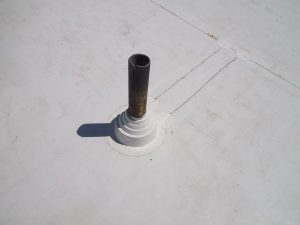
The racks holding the solar panels are mechanically fastened to your roof, you don’t want those expensive pieces of equipment falling off! Those points of installation are a massive vulnerability for leaks and heat/cool air loss.
With membrane systems, your contractor will have to create cuts in the membrane to work around the legs of the solar panel racks, similar to the vent you see in this image. With spray foam, you can have a contractor encase the entire installation point to form a seamless membrane going up the rack leg to stop leaks and keep your air inside the building.
Double Down on Going Green
If you are spending the money to install solar panels on your roof system, chances are you are trying to save money or the environment….or both! With spray foam roofing, you can double down on your investment.
Spray foam roofing will provide a higher insulation factor which will decrease your heating and cooling costs. You will also be using a sustainable roof system that will reduce your contribution to landfills.
Other Unique Uses of Spray Foam

Commercial Ductwork Insulation
Ductwork is one of the most important systems in your commercial building. According to Energy Star, 20 to 30 percent of the air that moves through a duct system is lost due to leaks, holes, and poorly connected ducts.
Improperly sealed ducts could contribute to energy loss for your facility and ultimately a monetary loss for your bottom line. A properly insulated ductwork system can protect your facility from variable temperatures, water damage, and mold.
Roof System Tie-Ins
Not all roofs are created equal. If you have multiple levels of roof systems or you have various types of roof systems, this can be a problem for potential leaks.
Spray foam can be utilized in an area where two different roof types meet. This area tends to collect substantial amounts of draining water as well as snow drifting. By installing the spray applied product, you create a seamless protective layer that prevents any water from backing up under the roof or flashings.
Non-Conventional Building Shapes
We have seen some unique buildings in our days, not every building is straightforward. The remarkable thing about spray foam is that your contractor creates a roof system as they apply the liquid onto your building. This means that they can cover non-conventional, even awkward shapes.
Traditional commercial roofing comes in prefabricated shapes – whether it’s a roll of the membrane or a sheet of metal. This means that the contractor has to work around your building shape, costing you time and money. The number of roof seams also increases when you introduce more pieces of roofing material.
Investing in a solar roof system is a big business decision when you are ready to invest, contact us to make sure your roof is prepared! If you have any further questions about your commercial roofing system, email us anytime at info@westroofingsystems.com or by filling out our form online to find out more.
*Cost ranges are general estimates; each roofing system is unique, and costs can vary. Please seek a professional quote for more specific and reliable costs.
Original Post Here: Spray Foam Roofing and Solar Panels: The Ultimate Match
Thursday, February 14, 2019
Commercial Gutters: Why Are They Important and How To Maintain Them
Gutter maintenance is not just for homes; proper gutter maintenance is vital to protect commercial facilities as well.
With 40 years of commercial roofing experience and a dedicated service team to visit and maintain our customers’ commercial roofs, West Roofing Systems knows the importance of proper preventative maintenance, and we want to share with you how to extend the life of your gutter systems for years.
What Are Building Gutters?
Commercial building gutters are roof accessories that can be attached around the perimeter or throughout the commercial roof to control the water flow to prevent damage to the roof, building, and underlying property. The control of water leaving the building prevents the water from falling off the sides of your building, protecting your property and tenants walking around.
There are a wide variety of gutters that are made for commercial and residential buildings. For a commercial building, typical building gutters are made of galvanized steel or heavy aluminum.
Why Is It Important to Maintain Building Gutters?
Gutters are an extremely important part of the roof systems; unfortunately, they are very often overlooked…until it’s too late. When commercial roof gutters are not adequately maintained, the water flow on the building can be disrupted. This disruption can cause major damage to your building, inside and out. From the foundation to walkways, improperly drained water can cost your hundred or thousands of dollars in damage.
How To Maintain Your Building Gutters
 Keep them Clean and Clear
Keep them Clean and Clear
Cleaning your gutters is not something that just homeowners have to deal with. Commercial buildings have gutters and drains that can get clogged with leaves, twigs, and other debris. When gutters and drains are clogged, water builds up and can sit on the roof, causing problems.
Keep your gutters clean and clear by going up regularly or hiring a contractor to visit your roof regularly to clean the gutters and drains on your building. You can even work to prevent debris from getting into your gutters by keeping trees and vegetation trimmed away from your building.
Maintain Gutter Joints
The joints of a gutter are the points where two pieces meet. These are vulnerable areas that can rust, break or disconnect. It’s important to regularly examine these areas of gutters and downspouts to ensure the gutter is carrying the water properly.
If you do have leaks at your gutter joints, these issues can be sealed with a waterproof gutter sealant.
Watch the Gutter Angle
Gutters drains, and downspouts use gravity to take water from the top of your roof to the ground safely. If your gutter systems don’t have the correct downward angle, they can collect water without sending it to the proper destination. This can cause major issues with your gutters and can even overflow onto your roof.
If you see water sitting in your gutters after rain, then you need to evaluate the pitch of your system.
Inspect for Holes
Holes and punctures to your gutter system can come from debris, weather or mechanical damage. These areas are prone to rust and can spread, allowing water to fall out of your gutter system in the damaged area.
Regularly inspect for damage, and especially check after severe weather. Most damage can be sealed with a patching kit, but if left for too long, you may have to replace that area of the gutter.
How A Maintenance Plan Can Help
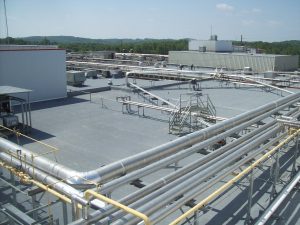 Roof maintenance refers to the work done on a commercial or residential roof to prevent extensive damage from occurring in the future. It takes a proactive approach to keep your roof from leaking. Preventative maintenance allows contractors to detect and fix areas of the roof that are vulnerable to future leaks.
Roof maintenance refers to the work done on a commercial or residential roof to prevent extensive damage from occurring in the future. It takes a proactive approach to keep your roof from leaking. Preventative maintenance allows contractors to detect and fix areas of the roof that are vulnerable to future leaks.
With a maintenance plan, you can work with a contractor that you trust to regularly visit your facility to examine your roof system, including your gutters, and perform all the preventative maintenance that you need.
When To Schedule Your Roof Maintenance
The National Roofing Contractors Association (NRCA) recommends maintenance and repair be performed at least twice a year; this usually falls in the Spring and Autumn seasons. These scheduled maintenance inspections are to prepare your facility roof for extreme weather of the Summer and Winter.
In addition to scheduled maintenance, it’s more important to have your roof maintenance team to your facility before and after severe weather (such as tornadoes, thunderstorms, hail or winter storms) to make sure any damage from the weather is minimized. Keep in mind that you want a contractor that has an emergency line in the event of water entering your building or any other drastic roof damage.
If you are looking for maintenance, repair or replacement of your facilities roof, fill out our quote request form for your free no-obligation commercial roof quote from our team of experts.
Choosing West Roofing Systems as a turnkey roofing company will provide you with highly trained teams and award-winning service. Our services are flexible and diverse; we can recoat, repair or replace your facility’s roof so that it lasts decades.
Post Source Here: Commercial Gutters: Why Are They Important and How To Maintain Them

